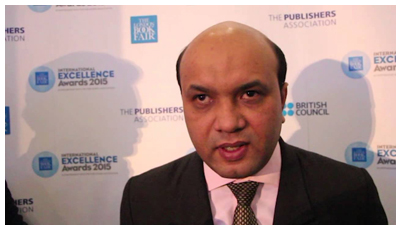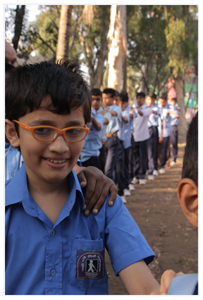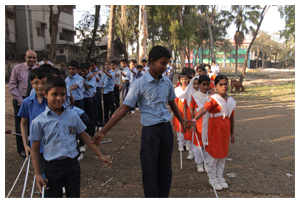- HOME
- Alumni News
- Activity Reports
- Vashkar’s Activity Report
Activity Reports
Vashkar’s Activity Report
Commitment to smart mobility for visually impaired in Bangladesh
14 October 2017
Author: * Isfaqul Kabir Sarker, Vashkar Bhattacharjee, Md. Shakhawatul Islam
 Isfaqul Kabir Sarker |
 Md Shakhawatul Islam |
 Vashkar Bhattacharjee |
|
The white cane was once considered as a mere stick to help visually impaired people detect obstacles in their way. Today though, that very cane has become a symbol of independence, self-reliance, confidence. As such, ever since 1964, people all around the world celebrate October 15 as the White Cane Safety Day.
 |
 |
 |
|
While there has been progress in this field, numbers suggest that there’s still plenty of room for improvement all around the world. The World Health Organisation following a survey in 2014 pointed out that 285 million people in the world suffer from visual impairment. Of them, 39 million are blind, while the rest have low vision.
What’s worse is that 90 percent of them live in low-income settings. As expected, they face difficulties in almost every stage of their life. Starting from getting access to education and healthcare to getting jobs at a later stage. The job sector scenario, according to WHO, is where the visually impaired people struggle the most.
Studies made in other parts of the world suggest similar outcomes. For instance, a research conducted in Iran states that all the visually impaired participants they interviewed were facing some kind of difficulty or the other on a regular basis. They range from walking on unsafe sidewalks, to finding it difficult to read bus numbers and crossing streets.
Keeping these numbers and outcomes in mind, the World Blind Union has urged authorities around the world for safe shared spaces. A shared space is defined as “a street or place designed to improve pedestrian movement and comfort by reducing the dominance of motor vehicles and enabling all users to share the space rather than follow the clearly defined rules implied by more conventional designs.” However, this increased complexity can make mobility more difficult for persons who are blind or partially sighted.
According to WHO (2011) figures, there are around 4 million visually impaired people in Bangladesh, a developing country, and it is facing similar problems. However, the country is conscientiously working on building strategies that help improve mobility of the visually impaired.
The Access to Information (a2i) programme of the Prime Minister’s Office in Bangladesh has been working on ways to improve their inclusive development. Innovators of all ages are being encouraged to come up with small-scale innovation prototypes which, if successful, can be upscaled to reach persons with disabilities.
One such innovation is a ‘Smart Cane’ developed by students who had participated in a contest organized by the a2i called the Solve-A-Thon. This GPS-enabled cane triggers vibrations and makes different kinds of noises to help persons with visual disabilities to navigate spaces by themselves.
Another project in the offing is the creation of an accessible road map, which is currently being developed with the help of the a2i’s Service Innovation Fund. This GPS-enabled mobile application can detect location and provide directions to the visually impaired as audio messages. It refers to important landmarks and gives warning messages in case the person heads towards a wrong direction. These two assistive devices, are just a start. A lot more work is being done to improve the situation including installing braille blocks on important streets and railway stations.
Besides making mobility easier, the Bangladesh government has already taken bold steps to make education accessible for the visually impaired. DAISY (Digital Accessible Information System) standard multimedia talking books, e-books and digital braille books have been introduced up to secondary level. These materials are not only more accessible but also more cost effective compared to the printed braille books and other related materials. Low-cost digital braille display and low-cost DAISY multimedia book players are being developed locally to read these books. In addition, accessible dictionary is available enabling persons with visual disabilities to learn English and Bangla languages better.
The government is now concerned with ensuring equal opportunity to higher education level for every student, irrespective of their physical and mental abilities, by creating inclusive university. a2i has partnered with one of the most reputed public universities to realize its vision of creating an inclusive university which will remain as an example for all other universities to follow.
Initiatives are being taken to ensure web accessibility for universal information and services which will further enable them and thereby the country in achieving the SDGs.
White Cane Safety Day is going to be celebrated this year, once again, as a demonstration for proclaiming rights of visually impaired people. There will be a special emphasis given on developing mechanisms that can give the visually impaired people their right to travel safely and independently. Bangladesh will also celebrate the day with the commitment to ensure smart mobility, using innovation and ICTs, for the blind.
* Isfaqul Kabir Sarker is working as a freelance writer in a2i Program
Vashkar Bhattacharjee is National Consultant for Accessibility at the a2i Program of the Prime Minister’s Office, Second Vice President of GAATES and a Program Manager at YPSA
Md. Shakhawatul Islam is an innovation associate in a2i Program




